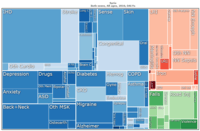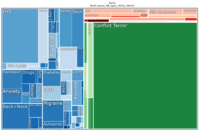Health in Syria
Health in Syria, although emphasized by the country's ruling Baath Party and improving significantly in recent years, has been declining due to the ongoing civil war which saw the destruction of many hospitals nationwide, and the deterioration in the functionality of some medical equipment due to the lack of spare parts and maintenance shortages of drugs and medical supplies due to sanctions.[1] Whatsoever, healthcare has been improving in government-held areas with many public and private hospitals still functioning.
Health expenditures reportedly accounted for 3.3 percent of the gross domestic product (GDP) in 2014.[2]
Population


In July 2017, Syria's population was an estimated 18,028,549.[2] In 2017, the average life expectancy for Syrians is 75 years, 72 for males and 77 for females,[2] compared to the average life expectancy in 1960, which was 52 years.[3] The total dependency ratio was 72.8 in 2015,[2] while the median age was 24 in 2017.[2]
Key health indicators in Syria show that infectious diseases and illnesses related to environmental pollution remain serious problems. The rate of prevalence of HIV/AIDS in 2001 was 0.01 percent.
Obesity
In 2017, the adult prevalence rate for obesity was 27.8, and in 2009 10% of children under 5 were obese.[2] In 2016, Syria ranked 35th in the list of countries by body mass index, according to the World Health Organisation data on Prevalence of Obesity, published in 2017.[4]
Sanitation
In 2015, 95.7% of the population had access to sanitation and 90.1% of the population had access to clean water.[2] Although water pollution poses a threat to the availability of clean water and sanitation, as analyses of water samples for ammonia, suspended solids and BOD in Aleppo's Quweiq River and the lower part of the Orontes exceeded the allowable limits.[5] In the coastal region, wells used for drinking purposes are contaminated with high concentrations of nitrates and ammonia because of sewage discharge and use of fertilizers, as well as seawater intrusion into the fresh groundwater aquifers.[5]
Smoking
Smoking in Syria is steadily increasing in popularity amongst Syrians, mainly in the forms of cigarettes or Narghiles. Syrians collectively spend about $600 million per year on tobacco consumption.[6] In 2010, 20% of women and 60% of men smoke and 98% of the overall population is affected by passive smoking.[7] Despite the assumption that smoking, specifically the narghile, is embedded in Syrian culture, this phenomenon has only recently become widespread.
Despite this, whatsoever, Smoking in Syria has been banned inside cafes (hookah bars), restaurants and other public spaces by a presidential decree which was issued on 12 October 2009 which went into effect on 21 April 2010. Syria was the first Arab country to introduce such a ban. The decree also outlaws smoking in schools, universities, health centers, sports halls, cinemas and theaters and on public transport. The restrictions include the narghile. According to the official Syrian Arab News Agency, fines for violating the ban range from 500 to 100,000 Syrian pounds (US$11 to $2,169).[8]
People under the age of 18 are not allowed to buy tobacco in Syria.[9]
Healthcare System
Syria’s health system is relatively decentralized and focuses on offering primary healthcare at three levels: village, district, and provincial. According to the World Health Organization (WHO), in 1990 Syria had 41 general hospitals (33 public, 8 private), 152 specialized hospitals (16 public, 136 private), 391 rural health centers, 151 urban health centers, 79 rural health units, and 49 specialized health centers; hospital beds totaled 13,164 (77 percent public, 23 percent private), or 11 beds per 10,000 inhabitants. The number of state hospital beds reportedly fell between 1995 and 2001, while the population had an 18 percent increase, but the opening of new hospitals in 2002 caused the number of hospital beds to double.
WHO reported that in 1989 Syria had a total of 10,114 physicians, 3,362 dentists, and 14,816 nurses and midwives; in 1995 the rate of health professionals per 10,000 inhabitants was 10.9 physicians, 5.6 dentists, and 21.2 nurses and midwives. Despite overall improvements, Syria’s health system exhibits significant regional disparities in the availability of healthcare, especially between urban and rural areas. The number of private hospitals and doctors increased by 41 percent between 1995 and 2001 as a result of growing demand and growing wealth in a small sector of society. Almost all private health facilities are located in large urban areas such as Damascus, Aleppo, Tartus, and Latakia.[10]
See also
References
- Kherallah, M; Alahfez, T; Sahloul, Z; Eddin, KD; Jamil, G (2012). "Health care in Syria before and during the crisis". Avicenna J Med. 2: 51–53. doi:10.4103/2231-0770.102275. PMC 3697421. PMID 23826546.
- "The World Factbook". CIA. Retrieved 23 February 2018.
- "Life expectancy at birth, total (years)". The World Bank. Retrieved 23 February 2016.
- "Health Topics, Obesity". World Health Organisation. Retrieved 14 December 2017.
- The Ministry of State for Environmental Affairs/World Bank/United Nations Development Program:Strategy and National Environmental Action Plan for Syria Archived 2007-07-01 at the Wayback Machine, 2003, accessed on October 31, 2009
- Mabardi, Roueida (April 29, 2010). "Smoking Ban Leaves Cafes Empty and Waterpipes Abandoned". The Daily Star: Lebanon. Retrieved 2 May 2012.
- "Smoking Ban Burns Syrian Businesses". Al Jazeera. Retrieved 2 May 2012.
- "Syria smoking ban enters into force". BBC News. 21 April 2010. Retrieved 22 April 2010.
- "Assad decrees Syria smoking ban". BBC News. 12 October 2009. Retrieved 4 April 2010.
- Syria country profile. Library of Congress Federal Research Division (April 2005). This article incorporates text from this source, which is in the public domain.

